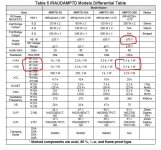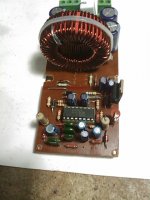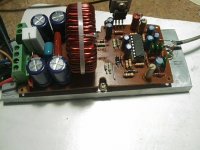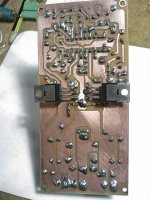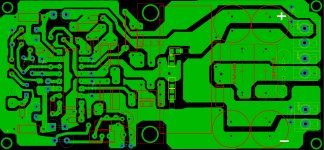Hello guys,
nothing happens here anymore?
As I have 11 L25D's running in my fully activated system I think about changing the power supply of the IRS2092. The IRS2092 is powered by the +-60 - 70V input of the module, which is then limited to ~ +-5,5V by the 5R1 resistor. The resistors are always quite hot and the voltage is just burned down, so I've been thinking about powering the IC's by an own power supply, which could be integrated behind the resistor (and removing the resistor).
My questions are:
1. Is there any influence to the output by changing the voltage of the IRS2092?
2. The datasheet says the VAA and VSS is 200V, but I hardly can't imagine such high voltage for the IC. Does anybody know, which voltage I can best choose for the IRS?
3. Is symetric power necessary?
Are there any other hints?
Thanks,
Stammheim
nothing happens here anymore?
As I have 11 L25D's running in my fully activated system I think about changing the power supply of the IRS2092. The IRS2092 is powered by the +-60 - 70V input of the module, which is then limited to ~ +-5,5V by the 5R1 resistor. The resistors are always quite hot and the voltage is just burned down, so I've been thinking about powering the IC's by an own power supply, which could be integrated behind the resistor (and removing the resistor).
My questions are:
1. Is there any influence to the output by changing the voltage of the IRS2092?
2. The datasheet says the VAA and VSS is 200V, but I hardly can't imagine such high voltage for the IC. Does anybody know, which voltage I can best choose for the IRS?
3. Is symetric power necessary?
Are there any other hints?
Thanks,
Stammheim
Last edited:
VAA and VSS are not 200 volt supplies.
They are limited internally by zeners to +/- 9 volts.
Ah!
So if I take a 2x7V transfomer I don't even need to use some LM's???
Or is there a voltage recommendation?
Last edited:
If I remember correctly IR used +5 and -5 volt regulators on none of their designs.
OK, but LJM does
There is +-5V behind the resistors to power up the IC.
So I still didn't understand, which is the right voltage range für the IRS?
Table resistors of the voltage
I had a look at the document and yes, that's the ~ +-5,4V behind the resistor. So the IRS is fed by the +-5,4V I already told. But as I have found nowhere I need to know, which voltage range the IRS can be powered, and if I implement an own power supply for the IRS, which voltage I have to put in. Of course I could go the easy way and also limit the voltage to the 5,4V, but because I would go with a 2x6V (or 2x7V) transformer it's important to know, if I have to use some voltage regulators to limit voltage.
Many thanks,
Stammheim
I had a look at the document and yes, that's the ~ +-5,4V behind the resistor. So the IRS is fed by the +-5,4V I already told. But as I have found nowhere I need to know, which voltage range the IRS can be powered, and if I implement an own power supply for the IRS, which voltage I have to put in. Of course I could go the easy way and also limit the voltage to the 5,4V, but because I would go with a 2x6V (or 2x7V) transformer it's important to know, if I have to use some voltage regulators to limit voltage.
Many thanks,
Stammheim
There is an internal zener that limits the voltage to around 7 volts.
To be safe I wouldnt go above +/- 5 volts.
There is an internal zener that limits the voltage to around 7 volts.
To be safe I wouldnt go above +/- 5 volts.
Thanks, I'll try this out. Do you also know the ampere-consumtion per IC? I guess a 15VA transformer should be enough for 8 IC's...?
Noah,
I guess another way to describe these (2092 based) class D amps is that they are 'lively' compared to other SS or class A, A/B amps.
Interesting. The Classdaudio.com IRS2092 amps (that started the IR craze) do not sound lively or edgy or anything like that at all. By and large the feedback has been the opposite: laid back, warm, tubey. That's been my experience as well. However from time to time there have been users who say their experience is edgy, thin, etc. So I can't help but think there is a system matching thing to be figured out. My speakers measure pretty flat and the last word I would use to describe the classdaudio.com IR amps is 'lively'.
Perhaps it's my speakers then that produce that lively sound - but I don't necessarily think so. IMO, it's anything but tube-esk like sound. Having said that though, the only class D audio amp that I hold in esteem is the class D ICE amp modules that Pioneer uses in their SC-xx HT receiver line. I've said it before and I'll state it again; they are the smoothest amps I've heard this side of the high-end audio - which I've heard very little of. And they continue to best any class D amp I've built. For sure, Pioneer and AirStudios have optimized the sound for HT use, but even in Pioneer's Pure Direct mode (no DSP), I could listen to them for hours without any fatigue whatsoever. It's like smooth butter to your ears.Interesting. The Classdaudio.com IRS2092 amps (that started the IR craze) do not sound lively or edgy or anything like that at all. By and large the feedback has been the opposite: laid back, warm, tubey. That's been my experience as well. However from time to time there have been users who say their experience is edgy, thin, etc. So I can't help but think there is a system matching thing to be figured out. My speakers measure pretty flat and the last word I would use to describe the classdaudio.com IR amps is 'lively'.
In fairness, my IRS2092 amp was connected to bookshelf speakers, so I wasn't ever listening at reference levels or trying to fill a large room with big sound. But those same, simple speakers sounded marvelous with the ICE amps. I say was, only because I don't currently have it hooked up to any system, since I just moved and in the process of building out my listening/mancave room.
Some people scoff at the little LJM 2092 modules, but for a budget amp I'm quite happy with the way they sound. I've never had one hooked up to a sub-woofer either, so that would make a big difference in the amount of bass I hear from my garden variety bookshelf speakers. To each his own I guess.
- Home
- Amplifiers
- Class D
- My design L20D IRS2092+IRFI4020H 200W8R
